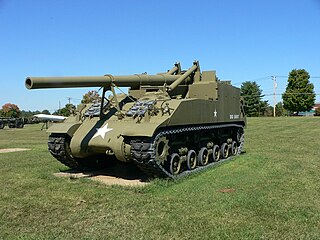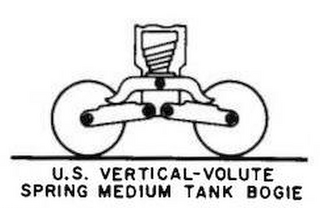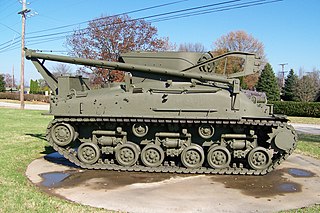Related Research Articles

A tank destroyer, tank hunter or tank killer is a type of armoured fighting vehicle, predominantly intended for anti-tank duties. They are typically armed with a direct fire artillery gun, also known as a self-propelled anti-tank gun, or missile launcher, also called an anti-tank missile carrier. The vehicles are designed specifically to engage and destroy enemy tanks, often with limited operational capacities.

The M4 Sherman, officially Medium Tank, M4, was the most widely used medium tank by the United States and Western Allies in World War II. The M4 Sherman proved to be reliable, relatively cheap to produce, and available in great numbers. It was also the basis of several other armored fighting vehicles including self-propelled artillery, tank destroyers, and armored recovery vehicles. Tens of thousands were distributed through the Lend-Lease program to the British Commonwealth and Soviet Union. The tank was named by the British after the American Civil War General William Tecumseh Sherman.

The TK (TK-3) and TKS were Polish tankettes developed during the 1930s and used in the Second World War.

The Sherman Firefly was a medium tank used by the United Kingdom and some armoured formations of other Allies in the Second World War. It was based on the US M4 Sherman but was fitted with the more powerful British 76.2 mm (3.00 in) calibre 17-pounder anti-tank gun as its main weapon. Conceived as a stopgap until future British tank designs came into service, the Sherman Firefly became the most common vehicle mounting the 17-pounder in the war.

An armoured recovery vehicle (ARV) is typically a powerful tank or armoured personnel carrier (APC) chassis modified for use during combat for military vehicle recovery (towing) or repair of battle-damaged, stuck, and/or inoperable armoured fighting vehicles, such as tanks and armoured personnel carriers. Most ARVs have motorized tracks, like a tank or bulldozer, enabling the ARV to operate on uneven ground. The term "Armoured Repair and Recovery Vehicle" (ARRV) is also used.

The M4 Sherman tank was produced in several variants, a result of mass production spread across several manufacturers and several years. It was also the basis for a number of related vehicles and Shermans have been modified by several nations, ranging from upgrades to complete hull conversions for another task. Originally designed in 1941, M4 variants were still used by Israel during the 1967 and 1973 wars with its Arab neighbors.

Tanks were an important weapons system in World War II. Even though tanks in the inter-war years were the subject of widespread research, production was limited to relatively small numbers in a few countries. However, during World War II, most armies employed tanks, and production levels reached thousands each month. Tank usage, doctrine and production varied widely among the combatant nations. By war's end, a consensus was emerging regarding tank doctrine and design.

An artillery tractor, also referred to as a gun tractor, is a specialized heavy-duty form of tractor unit used to tow artillery pieces of varying weights and calibres. It may be wheeled, tracked, or half-tracked.

The 155 mm Gun Motor Carriage M40 was an American self-propelled artillery vehicle built on a widened and lengthened Medium Tank M4A3 chassis, but with a Continental engine and with HVSS, which was introduced at the end of the Second World War.

This article deals with Sherman tanks extensive use around the world after World War II and catalogues foreign post–World War II use and conversions of Sherman tanks and variants based on the Sherman chassis.

The United States provided tens of thousands of its Medium Tank M4, also named the Sherman, to many of its Allies during the Second World War, under the terms of Lend-Lease.

The 76 mm gun M1 was an American World War II–era tank gun developed by the U.S United States Ordnance Department in 1942 to supplement the 75 mm gun on the basic Medium tank M4. It was also used to arm the M18 Hellcat tank destroyer.

The vertical volute spring suspension system is a type of vehicle suspension system. This type of the suspension system was mainly fitted on US and Italian tanks and armored fighting vehicles starting from throughout the 1930s up until after the end of the Second World War in 1945.

The United States has produced tanks since their inception in World War I, up until the present day. While there were several American experiments in tank design, the first American tanks to see service were copies of French light tanks and a joint heavy tank design with the United Kingdom.

Muzeum Broni Pancernej Centrum Szkolenia Wojsk Lądowych im. Hetmana Polnego Koronnego Stefana Czarnieckiego w Poznaniu, abbreviated Muzeum Broni Pancernej CSWL is a large collection of military vehicles, formerly located within Land Forces Training Center in Poznań, Poland.

This article deals with the history and development of tanks of the Polish army from their first use after World War I, into the interwar period, during World War II, the Cold War and modern era.

The M32 Armored Recovery Vehicle was an armored recovery vehicle (ARV) used during World War II and the Korean War by the United States, and was based on the chassis of the M4 Sherman medium tank. During World War II, the British also used several hundred M32s, which were obtained through Lend-Lease in 1944. The first four prototypes were produced in January 1943, labeled T5, T5E1, T5E2, T5E3, and T5E4. After a series of tests at the Aberdeen Proving Grounds, the prototypes were approved as M32, M32E1, M32E2, M32E3, and M32E4. However, the M32E4 never entered production. There were also variants that had Horizontal Volute Spring Suspension (HVSS), which were demarcated by the suffix "A1" after the model number.